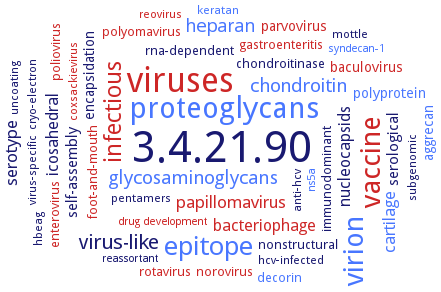3.4.21.90: Togavirin
This is an abbreviated version!
For detailed information about Togavirin, go to the full flat file.

Word Map on EC 3.4.21.90 
-
3.4.21.90
-
viruses
-
proteoglycans
-
virion
-
vaccine
-
epitope
-
infectious
-
virus-like
-
glycosaminoglycans
-
chondroitin
-
heparan
-
papillomavirus
-
serotype
-
cartilage
-
icosahedral
-
bacteriophage
-
nucleocapsids
-
self-assembly
-
serological
-
baculovirus
-
polyprotein
-
parvovirus
-
encapsidation
-
aggrecan
-
chondroitinase
-
immunodominant
-
enterovirus
-
decorin
-
norovirus
-
nonstructural
-
polyomavirus
-
poliovirus
-
rna-dependent
-
foot-and-mouth
-
gastroenteritis
-
rotavirus
-
reovirus
-
keratan
-
hbeag
-
mottle
-
pentamers
-
uncoating
-
subgenomic
-
anti-hcv
-
coxsackievirus
-
virus-specific
-
hcv-infected
-
cryo-electron
-
drug development
-
reassortant
-
ns5a
-
syndecan-1
- 3.4.21.90
- viruses
- proteoglycans
- virion
- vaccine
- epitope
- infectious
-
virus-like
- glycosaminoglycans
- chondroitin
- heparan
- papillomavirus
-
serotype
- cartilage
-
icosahedral
- bacteriophage
- nucleocapsids
-
self-assembly
-
serological
- baculovirus
- polyprotein
- parvovirus
-
encapsidation
- aggrecan
- chondroitinase
-
immunodominant
- enterovirus
- decorin
- norovirus
-
nonstructural
- polyomavirus
- poliovirus
-
rna-dependent
- foot-and-mouth
- gastroenteritis
- rotavirus
- reovirus
- keratan
-
hbeag
-
mottle
-
pentamers
-
uncoating
-
subgenomic
-
anti-hcv
- coxsackievirus
-
virus-specific
-
hcv-infected
-
cryo-electron
- drug development
-
reassortant
- ns5a
- syndecan-1
Reaction
Autocatalytic release of the core protein from the N-terminus of the togavirus structural polyprotein by hydrolysis of a -Trp-/-Ser- bond =
Synonyms
capsid protein, core protein, NsP2 proteinase, Sindbis virus core protein, Sindbis virus protease
ECTree
Advanced search results
Engineering
Engineering on EC 3.4.21.90 - Togavirin
Please wait a moment until all data is loaded. This message will disappear when all data is loaded.
drug development
-
alphavirus core protein is a target for antiviral chemotherapy
K102A
-
stronger binding affinity for encapsidation signal RNA than the wild-type
K109A
-
stronger binding affinity for encapsidation signal RNA than the wild-type
K83A
-
binding affinity for encapsidation signal RNA comparable to the wild-type
K86A
-
stronger binding affinity for encapsidation signal RNA than the wild-type
K97A
-
binding affinity for encapsidation signal RNA comparable to the wild-type
K99E
-
accumulates wild-type levels of nucleocapsid cores while still encapsidating approximately 65% viral RNA
K99E/R105A
-
accumulates wild-type levels of nucleocapsid cores while still encapsidating approximately 65% viral RNA
K99M
-
stronger binding affinity for encapsidation signal RNA than the wild-type
K99R
-
stronger binding affinity for encapsidation signal RNA than the wild-type
L108A
-
stronger binding affinity for encapsidation signal RNA than the wild-type
L110A
-
stronger binding affinity for encapsidation signal RNA than the wild-type
P100A
-
weaker binding affinity for encapsidation signal RNA than the wild-type
Q104A
-
binding affinity for encapsidation signal RNA comparable to the wild-type
Q94A
-
binding affinity for encapsidation signal RNA comparable to the wild-type
R103A/R105A
-
100fold reduced binding affinity compared to that of the wild type
R105E
-
weaker binding affinity for encapsidation signal RNA than the wild-type
R105K
-
stronger binding affinity for encapsidation signal RNA than the wild-type
R105L
-
weaker binding affinity for encapsidation signal RNA than the wild-type
R105M
-
weaker binding affinity for encapsidation signal RNA than the wild-type
additional information
-
mutants containing deletions of residues P(105) to D(118) and M(111) to D(118) in the core protein are viable, but the specific infectivity of these viruses is about 10fold less than the infectivity of wild-type virus. After lysis of infected cells or virus particles, mutant core protein with deletion of residues Q(40) to R(118) behaves as a monomer, whereby the core is generated during virus particle formation by the collection of core protein molecules by the viral membrane proteins prior to and/or during assembly of the viral surface proteins into an icosahedral shell
additional information
-
mutant containing a deletion of residues K(97) to M(106), wild-type-like cores are assembled in the cytoplasm, and particle formation is largely unaffected, but 26S subgenomic viral RNA, which is not incorporated into wild-type particles, is efficiently packaged into cores and virus particles. Mutations in the linker region and in neighbouring regions of the core protein have no effect on disassembly of viral cores during virus entry


 results (
results ( results (
results ( top
top






